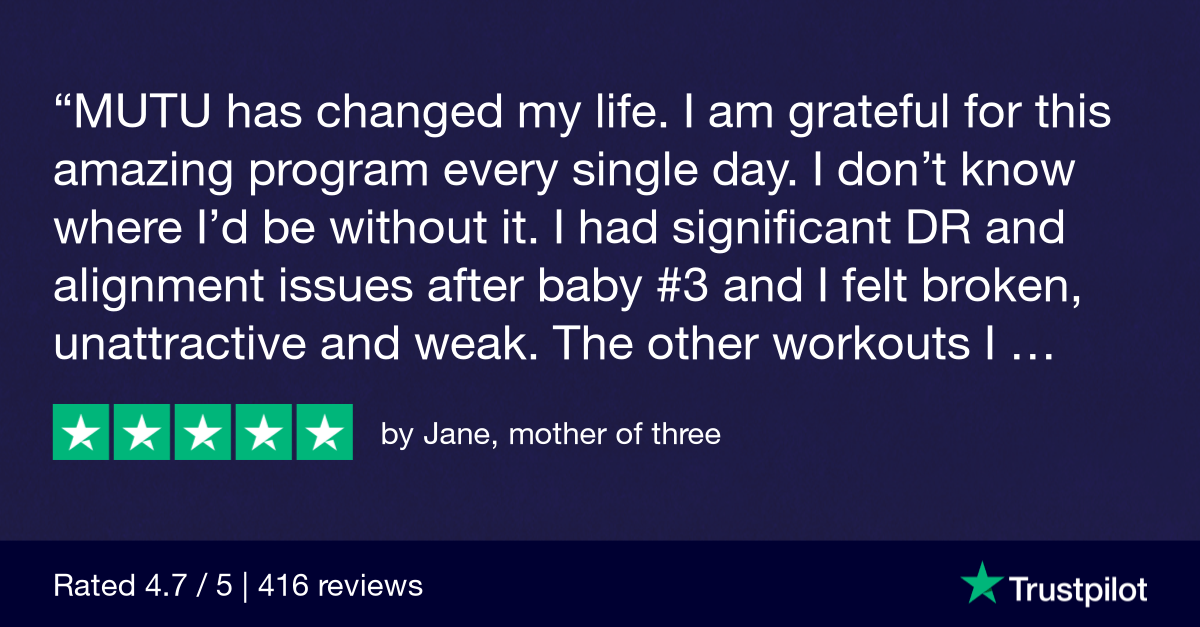Let’s talk about an issue that far too many women face – back pain after having a c-section.
If you’ve had a cesarean delivery and you’re experiencing discomfort you might be worrying whether it’s normal. And what you can do about it.
First up, please recognise that no matter how your birth unfolded, vaginal birth or cesarean birth – you are incredible! That is a superhuman feat you accomplished, bringing life into this world.
You deserve to enjoy all that comes next, back pain free.
Secondly, it’s important to know that there is so much that can be done to help address your c-section back pain now. It’s not something you simply have to learn to live with.
Understanding Back Pain After C-Section
With an increase in cesarean births (in the United States in 2022, 32.1% of births were cesarean deliveries) – it’s easy to forget that it is still a major abdominal surgery!
Postpartum back issues after having a cesarean are one of the most commonly reported symptoms experienced by mamas. At MUTU we regularly hear c-section recovery stories like Ashley’s where back pain and suffering in silence with ibuprofen and heat pads are a regular feature.
The Link Between C-Section and Back Pain
Generally speaking, you are more likely to have back pain if you have a c-section.
This is because it’s a major surgery that involves cutting through the abdominal muscles and uterus. Healing from this can cause pain and inflammation in the back muscles and nearby ligaments.
Additionally, the scar from a c-section can put strain on the back muscles. This can lead to discomfort, aches and soreness.
Also, as we’ll discuss later on, it’s possible that the spinal block administered for a cesarean can cause ongoing pain after birth.
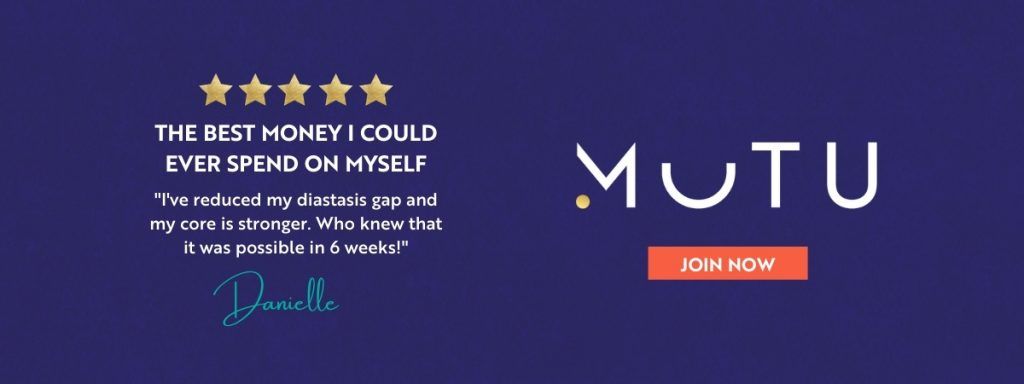
Types of Back Pain Post C-Section
Lower back pain
Lower back pain is very common after having a cesarean delivery. It’s not unusual for women to experience hip, leg pain or muscle spasms along with this type of back pain.
Your pelvic floor plays a big role in supporting the lower back. So if it is weak (or too tight) after giving birth this can put you under extra strain.
Upper back pain
Upper back pain is also an issue for many women after having a c-section. This can manifest itself high up the back in between the shoulder blades. Sometimes it’s experienced along with shoulder and/or neck pain.
It can be caused by many factors including; carrying additional weight, poor posture (when lifting, carrying or feeding your baby) or additional strain on the upper back after periods of inactivity.
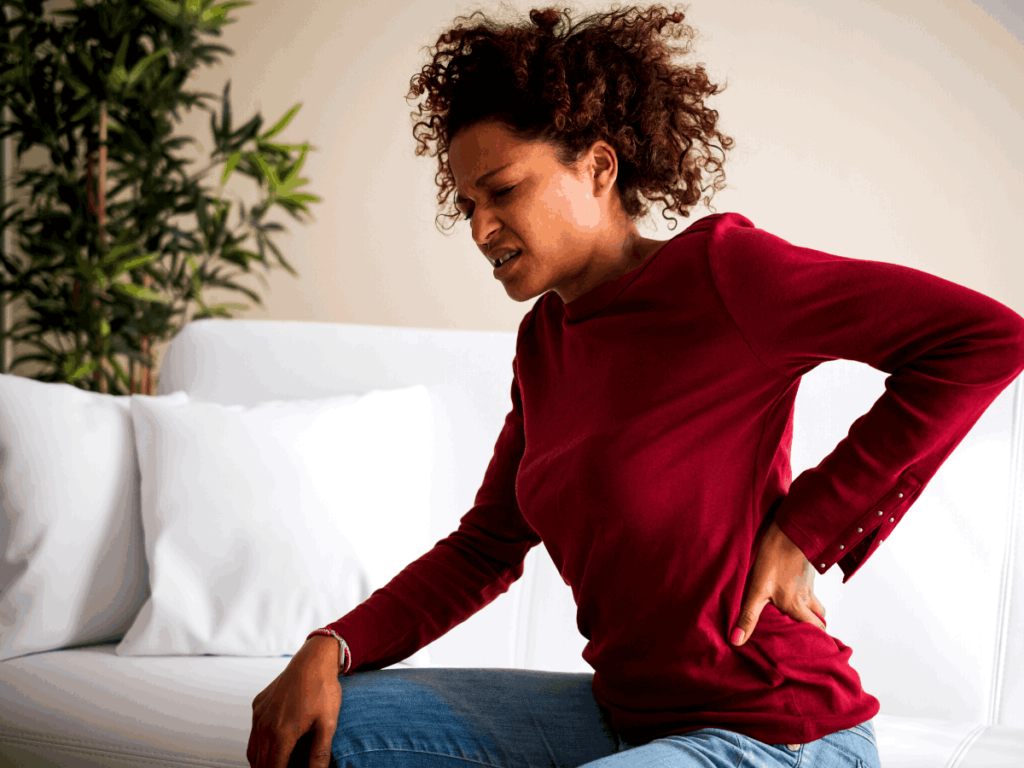
Factors Contributing to Back Pain
Your back pain could be occurring for a number of reasons. Let’s cover some of the short-term reasons, as well as solutions to help you banish that pain for good.
1. Pain and inflammation arising from the post-surgery healing process
C-section is a major surgery that involves cutting through the abdominal muscles and uterus. Healing from this can cause pain and inflammation in the back muscles and nearby ligaments.
2. Additional strain on the back muscles from c-section scars
Additionally, the scar from a c-section can put strain on the back muscles, which can lead to pain.
3. Anaesthesia and spinal block administration
The type of anaesthesia you receive before having a c-section could play a role. You may have had an epidural or a spinal block. An epidural takes longer to become effective and is injected into the surrounding areas of your spinal cord. Often for a c-section a spinal block is given. This is faster acting and is placed closer to the spinal cord. Back pain can be felt when the anaesthesia begins to wear off. Muscle spasms near the injection site can also occur.
4. Lingering back pain from longer labour
Often a c-section occurs after longer labours, particularly if there was a lengthy pushing phase. In that case, your chances of having lingering back pain in postpartum go up, also. Having to be more cautious, restful, and slower to get back into movement after this surgery can add up to back pain. Be mindful to move your body frequently but gently after a cesarean. This will help lower your risk of back pain.
5. Inactivity or a lack of movement leading to aches and pains
C-section is a major invasive surgery! With any major surgery there are going to be more restrictions post-surgery to ensure your body can heal safely. C-sections are no different. Rest frequently, don’t lift anything heavier than your baby, be gentle to protect stitches or staples. All of this, plus caring for a new little one, leads to less movement. This inactivity can cause more back pain and aches than normal.
6. Feeding your baby
If you’re nursing / breast-feeding, you may be contouring your body into weird positions you didn’t know were possible just to get your babe to latch and eat!
Once they are finally eating, the fear of moving (no matter how uncomfortable you might be) is very real. Hunching over to feed your baby and all the cirque du soleil-worthy positions you find yourself in, are not so kind on the back. All this can be a reason for back pain after c-section.
7. Lifting and carrying a baby
The incredible little human you just brought into this world might look tiny, but you’re now lifting and moving around a not insignificant extra weight in your arms every day!
As we bend and contort into a myriad of positions throughout the day to pick up, put down, bend over and lift – our posture can easily be impacted – leading to increased risk of developing back pain.
8. Hormones
Not all bodily changes during and after pregnancy are visible! Hormonal changes, especially the hormone relaxin, has the effect of loosening the joints, muscles and ligaments around the pelvic floor, back and abs.
These hormones (which are released whether you have a vaginal or cesarean delivery) are absolutely incredible in how they help us grow and deliver our babies but unfortunately, as a side effect, they do make our bodies slightly more vulnerable to strains, tweaks or hurting our backs.
9. Weakened core and pelvic floor
Our core is so much more than just our abs. It’s our lower back, pelvic floor, all our abdominal muscles, our glutes, and our hips – it’s our entire trunk or centre.
If you’re bending over, pushing, pulling, twisting, turning (as mamas, we do this all the time!) grabbing an escaping toddler, picking up toys, and your core is not flexible, strong and switching on… your lower back takes the strain.
Timeline of Back Pain Recovery
With many possible causes for your back pain, it’s impossible to give a “one-size fits all” recovery timeline.
Discomfort, soreness and pain can start in the immediate hours after delivery and can continue for days, weeks and sometimes many months after your surgery.
We’re all different and our body’s heal at different speeds, so each woman’s personal timeline will vary. Remember you’ve just had a major surgery – so don’t rush and if you need more time to recover – that’s totally okay.
Normalcy of Back Pain After C-Section
Back pain after a c-section is very normal.
Some studies have found that over 50% of postpartum women experience back pain after a cesarean. Back pain is also very common in postpartum women who have a vaginal delivery however much of the available research suggests that it is slightly less prevalent in comparison (the linked study found it was closer to 35%).
Whilst it’s very normal to suffer with back pain after your cesarean, it doesn’t mean you should ignore it or that you have to live with it.
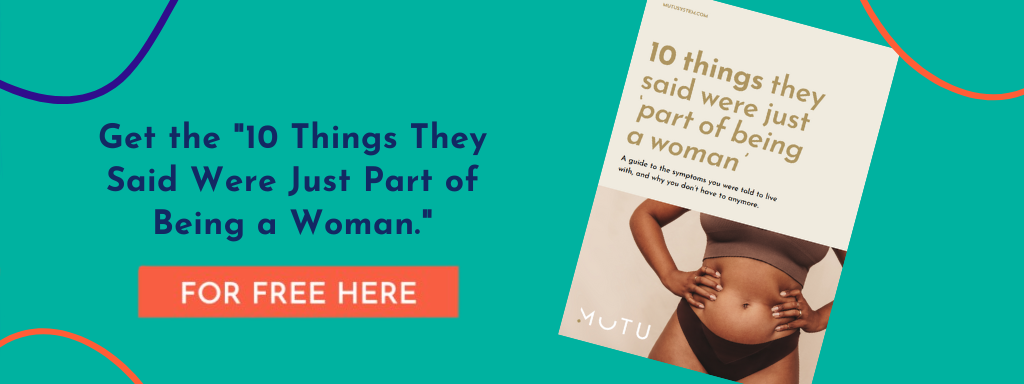
Common vs. Concerning Pain
When to Consult a Healthcare Provider
In most cases, post-c-section back pain is manageable on your own and goes away within a few weeks.
If you have severe discomfort or pain that doesn’t improve over time, you should see your healthcare provider sooner rather than later. There may be an underlying issue and your body is trying to alert you to it.
Here are some signs that your post-cesarean back pain may be a more serious issue:
- Severe discomfort, pain or soreness that gets worse over time
- Back pain that occurs with fever, chills, or other similar symptoms
- Discomfort, pain or soreness that makes it difficult to walk, sit, or stand
- Back pain that is accompanied by numbness or tingling in your legs
Addressing Anxiety and Concerns
Postpartum anxiety (excessive worrying, nervousness and/or panicking after giving birth) is a widespread issue for many moms and anxiety triggered by concerns about ongoing back pain can be a part of this.
The tricky thing with back pain is that it can both cause anxiety (why is my back hurting, why is it not getting better, what if it’s something more serious?) and be exacerbated by it (either from increased muscle tension or secondary factors like increased inactivity, changes to your posture or anxiety related hypersensitivity).
This can lead to a back and forth cycle that’s hard to get out of.
Firstly, we can’t stress enough – if you’re in any way worried about the discomfort you’re experiencing and it’s impacting your mental health you should reach out to your healthcare provider to talk to them.
Secondly, it’s important to remember that there are loads of things you can do to combat both the root cause of your back pain and to better manage any worries, concerns or fears you might have straight away.
From simple lifestyle adjustments to improved posture and gentle exercises designed around functional movement techniques (this is central to the entire MUTU system) to stress reducing activities like breath work can help you to start tackling the root causes from both sides.
Strategies To Overcome Back Pain After C-Section
Posture Correction Techniques
Whilst baby feeding
For baby feeding, use support, and lots of it!
Grab all the pillows around you and use them under your back, under your baby, under your arms, behind your shoulders. Support all the places that are supporting you feeding your baby. Get comfortable!
Not only will you enjoy the bonding with your baby more, but your back will appreciate it as well! Fed is best.
This advice is not just for nursing Moms! It’s every bit as important for bottle-feeding Mamas to make sure you are comfortable and fully supported as you feed your baby.
Focus on the bond that comes from feeding… and not the aches and pains that come from not being better supported.
Whilst bending over
When you are bending over make sure you are hinging from your hips, and not hunching and rounding forward.
This avoids more strain on your back. Exhale and gently engage as you lift to support your back and core better. When you are carrying your baby or anything else, try to keep your weight distributed evenly between your hips.
Avoid sticking one hip out to the side to lessen the load placed on your back.
Whilst standing and rocking
When you are standing and rocking your baby or standing and holding anything, check in on your alignment.
Make sure you are not arching your back, or lifting your ribs up (this places more strain on your lower back). Keep your ribs down and your back in neutral position. This will keep pressure off your back.
Also remember that your joints and ligaments will be looser postpartum due to hormones, so moving with care is important. Try to avoid sudden or jerky movements.
Generally speaking, trying to be more present to your posture when carrying out your day-to-day activities can help in bringing you relief from back pain.
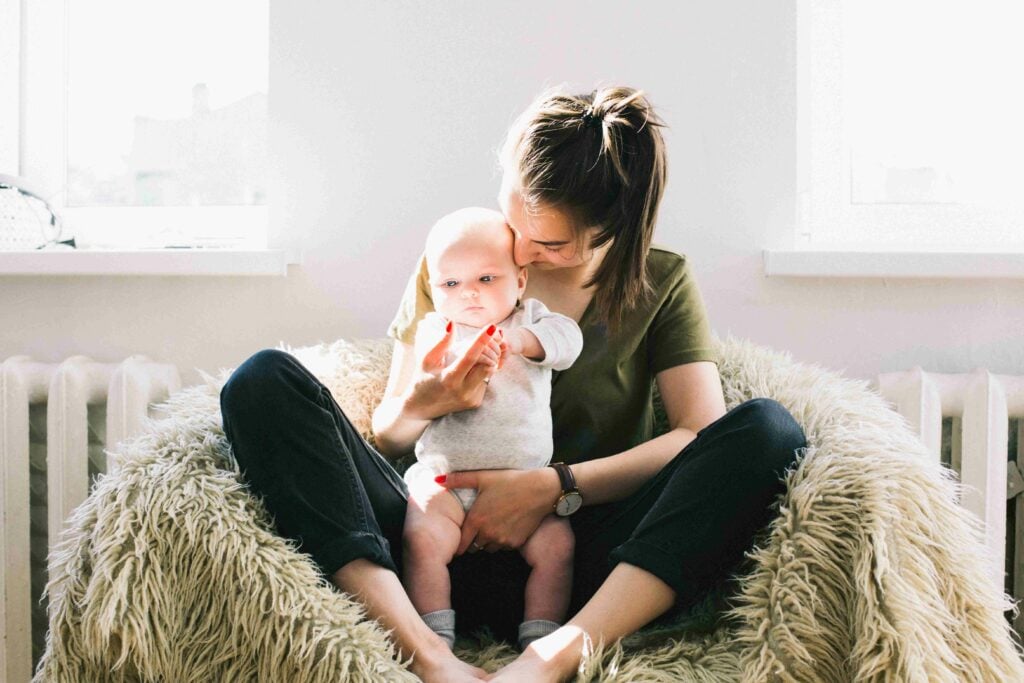
Gentle Exercises for Recovery
- Take slow short walks. You don’t need to be an olympic speed walker. Set realistic goals. A starting goal could be to the end of your driveway and back, gradually building to a walk around the block. Walking is amazing with many benefits, one is helping ease back pain.
- Start as soon as you can with breathing work and mindfully reconnecting to your body through light muscle engaging exercises. Learning how to first ‘find’ your core muscles is the most vital, effective stage of exercise – and you can do it from your bed at first. This is literally breathing and re-connecting, to find the right muscles.
- Once you’ve healed properly from the surgery, you can begin to introduce a wider variety of gentle core and pelvic floor exercises into your routine. From bends and stretches to pelvic tilts and mobility exercises we’ve rounded up an introduction to our favourite postpartum back pain exercises here.
Learn more about c-section recovery exercise planning here.
Pain Management Approaches
Speak up and be honest with your doctor, let them know your back is hurting and if there is anything that can be done to help. If you’re suffering with pain and discomfort this should not be ignored or simply masked with painkillers.
Role of Physical Therapy
When it comes to physical activity after a c-section you might think you need to wait to do any kind of movement. Not true!
Start to move as soon as you feel ready. Your focus during the early weeks won’t be your typical ‘exercising’, what you focus on will be breathing and reconnecting your brain to your tummy and your pelvic floor.
The sooner you do this after any type of birth, the better. You need to re-establish this reconnection so any exercise you eventually do will be truly beneficial.
Generally speaking, physical activity including stretching, bending and exercise can help improve back pain after a c-section (even after long periods of time) by strengthening your core and pelvic floor leading to more stability, better posture and improved support for your lower back.
We have some great exercises to help relieve your back pain here.
Be mindful that some exercises may be unsuitable and best to avoid if you have persistent back pain. Common core exercises such as sit-ups, crunches or excessive twisting can exert too much pressure which may exacerbate low-back pain further.
Incorporating Abdominal Binders
Blinding or splinting has limitations as a ‘fix’ for core problems but if you choose to wear a wrap of some description postpartum for comfort and support, it may provide relief alongside strategies to address the causes.
MUTU System is based on the principle that back pain is a symptom (not the root cause) of another issue (such as a compromised, weak core and a misaligned pelvis).
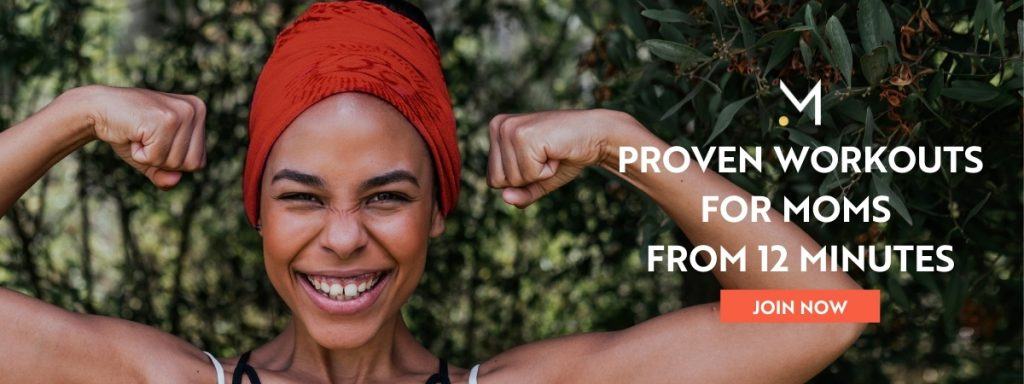
Emotional Impact of Back Pain
Back pain manifests itself as a physical problem. But as we discussed earlier, (and as anyone who’s experienced back pain can attest to) it’s important to pay attention to our emotions and mental health – as things can quickly spill over into psychological distress.
When we’re restricted in our everyday activities, physical movements or our sleep is disrupted this has a massive impact on our quality of life and can seem all-consuming.
And the research backs this up. Studies into postpartum back pain have shown that emotions like anxiety, irritability, sadness, fear and loss of hope can often take centre stage in chronic back pain.
Psychological Well-being and Coping Strategies
We would always strongly advise that you speak to your doctor first and foremost if you are struggling with any kind of mental health issues or are concerned about any pelvic health issues.
They will be able to refer you to the right specialists to help you to recover properly.
Support Systems and Communication
With thanks to our friends at the Global Pelvic Health Alliance Membership (GPHAM) for providing these resources:
- TRE™ – for trauma-informed, preventative and recovery care. You can find a practitioner here.
- APPPAH – Association of Pre and Perinatal Psychology and Health
- Postpartum Support International – Postpartum Support International is dedicated to helping families suffering from postpartum depression, anxiety, and distress.
- Postpartum Health Alliance – Whether you are a mom who is struggling, a concerned friend or relative, or a health professional, Postpartum Health Alliance can offer you support.
- Institute for Birth Healing (advanced practitioners) – Birth healing specialist business directory
You can also join the conversation and share your experience over on our Facebook or Instagram page to connect directly with other moms.

Relaxation Techniques and Stress Reduction
Firstly, you must prioritise rest, recovery and looking after your baby.
For additional relaxation and stress reduction both breathwork and mindfully reconnecting to your body through light muscle engaging exercises are a great starting point.
How to Gradually Resume Activities
As mentioned above, incorporating gentle movement such as walking into your routine early can be great for healing and low impact.
Go for a walk outside as soon as you feel able, and try to make this a daily activity. Walking and fresh air will help your emotional health, as well as increase circulation to aid healing and scar tissue.
Building Core Strength After C-Section
Feel ready to exercise after C Section? First ‘finding’ the core muscles is the most vital, effective stage of exercise – and you can do it from your bed at first. So start as soon as you can.
This is literally breathing and re-connecting, to find the right muscles. You can’t even begin to strengthen what you’ve temporarily lost all connection with. And the sooner you do this after any type of birth, the better.
Finding your core muscles
- Get comfortable and take a couple of deep breaths to settle. Drop your shoulders. Drop your ribs.
- Inhale and let your abdominal muscles and pelvic floor fully relax. Just let everything release as much as you can and breathe in
- Exhale slowly as you lift and gently squeeze your pelvic floor. To find the right muscles, imagine you’re trying really hard not to fart. Or that you’re drawing a super-plus tampon up inside you
- Breathe in again and fully relax. Don’t push away or down, just let it all go as you inhale
- Repeat the exhale and pelvic floor lift. None of these movements are at all forceful, just gentle breathing exercises to reconnect your breath to your core
You may feel your abdominal muscles drawing in or tensing slightly as you engage your pelvic floor. This is good!
The system is all connected and this tells you it is working. But don’t worry if you feel nothing at all in your abs for now. Some numbness and lack of sensation after a cesarean is normal.
The more consistently and regularly you can follow all these strategies, the more you will encourage your abs back to life.
Remember to always roll to your side first as you get up from lying on your back, don’t sit straight up. And totally avoid sit-ups or crunches…
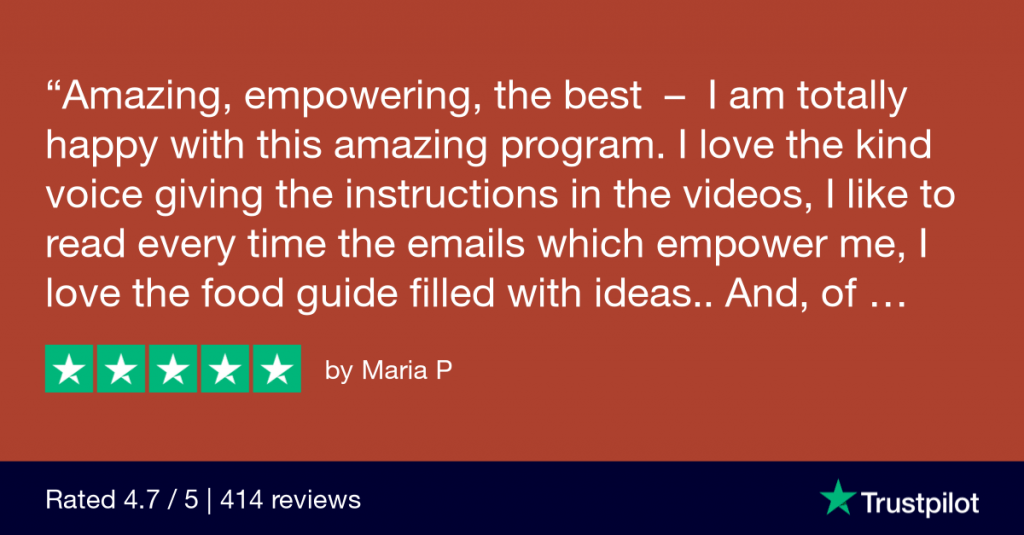
Tips For Maintaining Back Health for the Future
1. Daily movement and core strengthening
This doesn’t mean doing 100 crunches as fast as you can, BTW.
It means moving your body in a way that makes you feel good and reconnecting with the deep core muscles and that starts with ‘finding’ them.
2. Change your shoes
Yup seriously, your shoes are affecting how optimally your core can do its job, and when they hinder your core from doing its job, your back will hurt.
High heels are not helping. They are skewing your alignment, throwing all the stacked parts out of kilter and your back is taking the strain.
In MUTU we talk about shoes a lot and encourage minimal or barefoot shoes. But for the purposes of this blog… I’m just gonna say, lose the heels as often as you can and if you are suffering from lower back pain – definitely try it.
3. Squat, baby!
Your glutes play a big role in your core strength and confidence.
If your glutes are not doing their job, your pelvic floor suffers, and so does your back. Gluteal muscles not only stabilise around your tailbone, but they also help support your low back muscles. If the glutes are weak, the low back muscles have to work harder, which makes them fatigued and sore.
Squats, baby. We squat a lot in MUTU too. MUTU teaches you to protect your back, and build glutes as you squat.
A final important takeaway
The most important takeaway is that there is so much that can be done to help address your back pain now, it is not something you just have to learn to adjust to and deal with.
You deserve to be pain free, to be able to enjoy motherhood and to be fully present in your life.
If you have been dealing with back pain for quite sometime now check out our post on managing long term back pain after a c-section and natural methods for healing including our best exercises for postpartum back pain.
